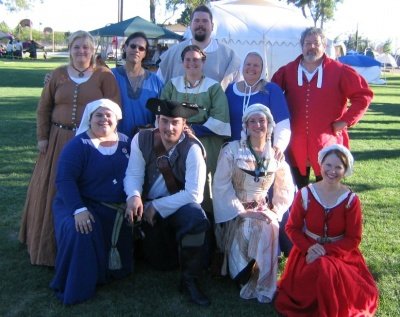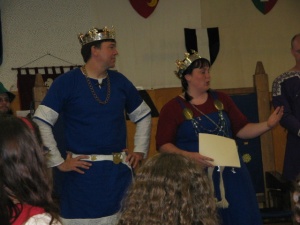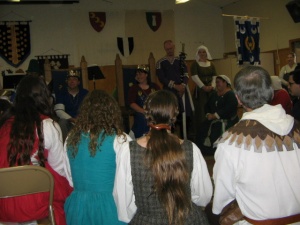Circle of Bards
The Right Noble Circle of Bards is a loose affliation of all the Bards in Caid. There are various local bardic workshops, guild meetings, and occasional Kingdom-wide activies. In addition, some of the bards within Caid are also involved with the Crown Poems projects. For each Crown Tourney, a collection of poems are written and published at Coronation, in tribute to each fighter in the Crown Lists.
The Kingdom conducts a yearly competition to determine the Bard of Caid. In addition, some geographic branches have formed their own territorial champion bards.
Right Noble Circle of Bards
The Guild was awarded Right Noble status on 08/26/2006 by Sven and Kolfinna, at Kolfinna's Festival of the Rose.
Bard of Caid

Lineage
- At Highland War 9/3/2005, Dietrich III and Adriana II conducted the first competition to name the Bard of Caid. Finella Harper was named the Premier Bard of Caid, and incidentally served the longest term as Bard since the 2nd competition was postponed several times.
- At 12th Night on 1/6/2007, Edric IV and Faizeh hosted the second Bard of Caid competition, where Elizaveta Arievna Lebedeva (also known as Lilya) was named the Bard of Caid.
- At 12th Night on 1/5/2008, Edric V and Faizeh II hosted the third Bard of Caid competition, where Eilidh Swann Stralachlan was named the Bard of Caid.
- At 12th Night 2009, Sven II and Kolfinna II hosted the fourth Bard of Caid competition, where Lot Ramirez was named the Bard of Caid.
- At 12th Night 2010, Patrick and Kara hosted the fifth Bard of Caid competition, where Eadaoin inghen Muircheartaigh was named the Bard of Caid.
- At Twelfth Night 2011, Wilhelm and Thaleia hosted the sixth Bard of Caid competition, where Thomas Whitehart was named the Bard of Caid.
- At Twelfth Night 2012, Sven III and Cassandra hosted the seventh Bard of Caid competition, where Maluchka Korotkova was named the Bard of Caid.
Purpose
To choose an exemplar of The Muse who will strive to ennoble The Realm in verse and song and bring glory to The Kingdom.
Defining the Bard of Caid Position
- Skill is required in both composition and performance.
- The holder of the title of Bard of Caid shall be one person, not a group consortium: However, the competing bard may use backup musicians or singers.
- The holder of the title shall be determined by competition, judged in a similar manner to Pentathlon.
- The Bard of Caid shall owe his/her Primary Fealty to the Kingdom of Caid.
- The Bard of Caid may not succeed himself/herself.
- This competition is open to singers, poets, storytellers, actor-playwrights, and musicians.
Responsibilities of the Bard of Caid
- The position of Bard of Caid shall carry a 1-year commitment that includes three required Kingdom Events (Twelfth Night, Great Western War, and the competition for his/her successor). Additional events will be determined by the King & Queen, based on the Bard of Caid’s available schedule.
- The Bard of Caid shall perform pieces, either original or historical, at the aforementioned events. The pieces composed do not have to be composed specifically for that event.
- The Bard of Caid shall compose an original piece for Twelfth Night, Great Western War, and on or about May 1st of each year. The compositions should be composed with the specific intent to bring glory to The Kingdom of Caid or The Crown. The composition could be a battle song, a love song, a praise poem, a satire, or whatever the Bard of Caid feels inspired to compose.
- The Bard of Caid is strongly encouraged to publish a piece in The Crown Prints or The Ars Caidis, The Kingdom Arts & Sciences publication.
- The Bard of Caid will run the competition that determines his/or her successor.
- If for some reason, the Bard of Caid is unable to fulfill the responsibilities of his office, then the position shall go to a person appointed by the Crown.
Rights and Regalia
- The Bard is entitled to a front row seat at major event courts.
- The Bard of Caid shall have a baldric or cloak that will identify him/her as the Kingdom Bard. This garment IS kingdom regalia: it will be returned at the end of the Bard of Caid’s year tenure.
Rules For The Competition (2012)
This year's Theme is HUMOR. The Competition for Bard of Caid shall consist of the following 4 rounds (subject to TRMs pleasure):
- Round 1: A period piece or an original piece in a period style. [Documentation highly encouraged. May be original or someone else's composition.]
- Round 2. A piece the performer considers his/her best. [May be original or someone else's composition.]
- Round 3. A piece that is humorous, and includes some audience participation [May be original or someone else's composition. May include props, but props are not required.]
- Round 4. An original composition to be composed on-site, which will include 3 words announced at competition. [Must be composed the day of the event, on-site. Competitors will be assigned the three words that must be included, at the end of Opening Court. If you miss the announcement in court, please see THLord Thomas Whitehart before the Competition begins.]
Please contact me [truethomas at sbcglobal.net] (or in person) that you plan to enter.
Supporting rules for the four rounds
- (A) One piece, minimum, must be an original composition. You may have up to three pieces that are not composed by you, or you may have as many original compositions as you like.
- (B) The key words to be included in the original composition on site will be announced at Opening Court. The Competition will be held approximately 60-minutes later, to give the competitors time to finish their compositions.
- (C) Original musical pieces may be performed to existing music, as long as that existing music is either out of copyright, or the lyricist has the copyright holder’s permission. If a pre-existing tune is used, the judges shall show preference for tunes composed before 1650.
- (D) Documentation is required to describe the attribution and background of the historical piece, and to describe the style of the original piece. Documentation is optional for the piece the competitior considers his/her best.
- (E) Copies of lyrics, when appropriate, should be provided for the judges.
- (F) The judges will include the current Bard of Caid, Their Majesties of Caid (if possible), and others chosen by either Their majesties or the current Bard of Caid.
- (G) The longest piece may not exceed 8-10 minutes. Please be considerate. The total time of all four pieces for a given performer should not exceed 20-25 minutes.
- (H) Suggested performances can include (but are not limited to) singing, instrumental performance, dramatic prose, poetry, use of foreign languages, and story-telling.
History of Competition Rounds
In each of the first four competitions, the Bards were required to perform (a) a piece they considered their best and (b) a period piece or an original piece in a period style. Additional, each has a (c) piece about the following theme... and (d) an original composition from these words announced the day of the event.
Theme Piece
- 2005 - The topic of "Virtue"
- 2007 - The topic of the poet Rumi, or inspired by his life
- 2008 - The topic of honor, or inspired by same
- 2009 - About or inspired by the one or more of the Seven Knightly Virtues: Courage, Justice, Mercy, Generosity, Faith, Nobility, Hope
- 2010 - A piece themed on "Castle" or "Fortress" -- About, evoking, reminds one of, etc.
- 2011 - A piece themed on "Myths and Legends"
- 2012 - A piece themed on "Humor"
Three Words From a Hat
- 2005 - Moon, Hare (like the bunny), and Love
- 2007 - Hands, Honor, and Scion (heir to your estate)
- 2008 - Silver, Chaste, and Merit ...with bonus extra credit points for the extra word "Lentil"
- 2009 - Heart, Night, Blue ...with bonus extra credit points for the extra word "Sloth"
- 2010 - Travel, Oath, Love ...with bonus extra credit points for the extra word "Lemming"
- 2011 - Reflection, Loyalty, Iron ...with bonus extra credit points for the extra word "Strawberry"
- 2012 - To Be Determined!
Territorial Bards
Bard of Altavia
- First competition held: Altavia Anniversary and Investiture for Thorin and Courtney, 5/10/2008 - Winner: Secca of Kent (then known as Secca of Cantia)
- Altavia Anniversary, 5/09/09 - Caitlin of Altavia with The Glory of Caid
- Altavia Yule, 12/5/2009 - Mealla Caimbeul for performances of Band of Brothers and The Murder of Thomas a Beket aka Nunc Gaudet Ecclesia
- Altavia Yule 2010, 12/11/2010 - the Altavian Bardic Champion-at-Large is Lady Bryn Kjolfari and the Bard of Altavia is Lady Petronilla de Chastelerault
Bard of Calafia
- First competition held: Calafia Anniversary 11/3/2007 - Éadaoin inghen Muircheartaigh
- Calafia Anniversary, 11/15/2008 - Liudmila Vladimirova doch'
- Calafia Yule/Winter Arts, 12/5/2009 - Maluchka Korotkova
- Calafia Yule/Winter Arts, 12/4/2010 - Guillaume de Belgique
Bard of Darachshire
- Black Oak Lodge, 3/15/2008 - Premier Bard of Darach Magdalene van den Velde
- Black Oak Lodge, 3/14/2009 - Eilidh Swann Stralachlan
Bard of Dreiburgen
- First competition held at Dreiburgen Yule, 12/04/2010 - Robynne the Grey
Bard of Dun Or
- First competition held at Dun Or Anniversary, 10/13/2007 - Mealla Caimbeul
- Dun Or Anniversary, 10/18/2008 - Andrew Baird
Bard of Gyldenholt
- First competition held at Gyldenholt Yule, 2008 - Winner: Finella Harper
- Gyldenholt/Lyondemere Yule, 12/19/2009 - Finella Harper
- Gyldenholt/Lyondemere Yule, 12/11/2010 - Caitlin Christiana Wintour
Lyon Bard (Barony of Lyondemere)
- Premier Lyon Bard 2002-03 - Finella Harper
- 2nd Lyon Bard 2003-04 - Arthur FitzRobert of Wiverneweald
- 3rd Lyon Bard 2004-05 - Elizaveta Arievna Lebedeva
- 4th Lyon Bard 2005-06 - Eilidh Swann Stralachlan
- 5th Lyon Bard 2006-07 - Domhnall mac Pharlain
- 6th Lyon Bard 2007-08 - Beathog nic Dhonnchaidh
- 7th Lyon Bard 2008-09 - Caitlin Christiana Wintour
- 8th Lyon Bard 2009-10 - Cecilia Lightfoot
- 9th Lyon Bard 2010-11 - Avice de Baiona
Seraph Bard (Barony of Angels)
- Won Sherwood Bard at Robin Hood Archery Tournament, 2005: Lot Ramirez
- The Sherwood Bard was declared the Bard of Angels, at the coronation of Dirk V and Chamayn II 11/12/2005
- Bard 2006: Robert Lanternsmith
- Bard 2007: Katerina Magdalena Stoianovna
- Bard 2008: Katerina Magdalena Stoianovna
- Seraph Bard 2009: Petronilla de Chastelerault - Name change from Sherwood Bard to Seraph Bard
More Information
| Guilds of Caid |
|---|
| Kingdom Guilds: Academy of Equestrian Arts, Arachne's Web, Blue Feather, Blue Nails Dyers, Brewers' Guild, Circle of Bards, Company of Archers, Company of Clothiers, Hounds of Caid, Metalworkers' Guild, Middle Eastern Guild, Newcomers Guild, Potters' Guild, Royal Crescent Navy, Saint Genesius
Other Information: Local Guilds, Former Guilds, Officers |

